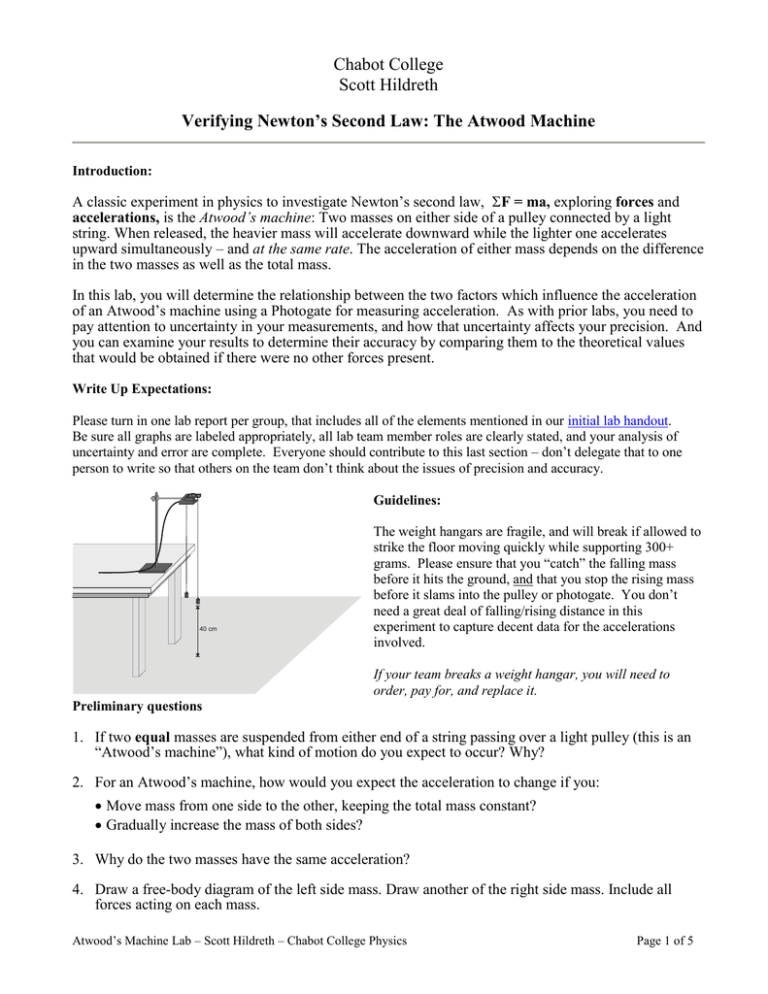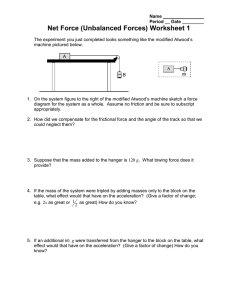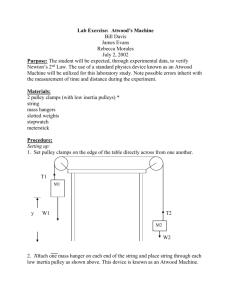Physics 4A Lab - Scott Hildreth
advertisement

Chabot College Scott Hildreth Verifying Newton’s Second Law: The Atwood Machine Introduction: A classic experiment in physics to investigate Newton’s second law, F = ma, exploring forces and accelerations, is the Atwood’s machine: Two masses on either side of a pulley connected by a light string. When released, the heavier mass will accelerate downward while the lighter one accelerates upward simultaneously – and at the same rate. The acceleration of either mass depends on the difference in the two masses as well as the total mass. In this lab, you will determine the relationship between the two factors which influence the acceleration of an Atwood’s machine using a Photogate for measuring acceleration. As with prior labs, you need to pay attention to uncertainty in your measurements, and how that uncertainty affects your precision. And you can examine your results to determine their accuracy by comparing them to the theoretical values that would be obtained if there were no other forces present. Write Up Expectations: Please turn in one lab report per group, that includes all of the elements mentioned in our initial lab handout. Be sure all graphs are labeled appropriately, all lab team member roles are clearly stated, and your analysis of uncertainty and error are complete. Everyone should contribute to this last section – don’t delegate that to one person to write so that others on the team don’t think about the issues of precision and accuracy. Guidelines: 40 cm The weight hangars are fragile, and will break if allowed to strike the floor moving quickly while supporting 300+ grams. Please ensure that you “catch” the falling mass before it hits the ground, and that you stop the rising mass before it slams into the pulley or photogate. You don’t need a great deal of falling/rising distance in this experiment to capture decent data for the accelerations involved. If your team breaks a weight hangar, you will need to order, pay for, and replace it. Preliminary questions 1. If two equal masses are suspended from either end of a string passing over a light pulley (this is an “Atwood’s machine”), what kind of motion do you expect to occur? Why? 2. For an Atwood’s machine, how would you expect the acceleration to change if you: Move mass from one side to the other, keeping the total mass constant? Gradually increase the mass of both sides? 3. Why do the two masses have the same acceleration? 4. Draw a free-body diagram of the left side mass. Draw another of the right side mass. Include all forces acting on each mass. Atwood’s Machine Lab – Scott Hildreth – Chabot College Physics Page 1 of 5 Experiment 1: HOLD Total Mass constant, but change it from one side to another to vary acceleration. If Force increases, will acceleration increase, given a fixed mass? For this part of the experiment you will keep the total mass distributed between the two sides of the Atwood’s machine constant and slowly increase the difference in mass from one side compared to the other; it is this difference that creates the motive force. 1. Set up the Atwood’s machine apparatus as shown in Figure 1. Be sure the heavier mass can move at least 40 cm before striking the floor. 2. Connect the Photogate with Super Pulley to DIG/SONIC 1 of the LabPro or DG 1 of the Universal Lab Interface. 3. Open the file in the Experiment 10 folder of Physics with Computers. A graph of velocity vs. time will be displayed. 4. Arrange a collection of masses totaling 200 g on m2 using mostly 10-g and 20-g masses, and a total of 200g on m1 using (2) 100-g masses. What is the acceleration of this combination? Record your values for mass and acceleration in the data table. 5. Move 10 or 20 g from m2 to m1. Record both resulting masses in the data table. 6. Position m1 as high up as it can go. Click to begin data collection. Steady the masses so they are not swinging. Wait one second and release the masses. Catch the falling mass before it strikes the floor or the other mass strikes the pulley. Please be careful with the falling mass hangar - catch it or let it hit a soft surface, not the floor! 7. Click the Examine button and select the region of the graph where the velocity was increasing at a steady rate. Click the Linear Regression button to fit the line y = mx + b to the data. Record the slope, which is the acceleration, in the data table. 8. Continue to move masses from m2 to m1 in 10 or 20-g increments, changing the difference between the masses, but keeping the total constant. Repeat Steps 6 - 7 for each mass combination. Repeat this step until you get at least five different combinations. From the data in the first experiment, graph measured acceleration (vertical axis) vs. Net Force (horizontal axis). Using simple linear regression tools (available in LoggerPro or Excel), find the slope that best fits the line, and explain what that slope represents. Evaluate the coefficient of determination (R2) for the linear regression fit. Also find the intercepts to the x and y axes, and explain what they represent! Based on your analysis of the graph, what is the relationship between the mass difference and the acceleration of an Atwood’s machine? Acceleration Net Force Atwood’s Machine Lab – Scott Hildreth – Chabot College Physics Page 2 of 5 Experiment 2: HOLD F constant, but increase mass to vary acceleration. If Mass increases, will acceleration decrease, if the force causing motion stays the same? For this part of the experiment you will keep the difference in mass between the two sides of the Atwood’s machine constant and slowly increase the total mass being moved. 9. Put 120 g on m1 and 100 g on m2, using 100-g masses and one 20-g mass. 10. Position m1 as high up as it can go. Click to begin data collection. Steady the masses so they are not swinging. Wait one second and release the masses. Catch the falling mass before it strikes the floor or the other mass strikes the pulley. Please be careful with the falling mass hangar - catch it or let it hit a soft surface, not the floor! 11. Click the Examine button and select the region of the graph where the velocity was increasing at a steady rate. Click the Linear Regression button to fit the line y = mx + b to the data. Record the slope, which is the acceleration, in the data table. 12. Add mass in 20-g increments to both sides, keeping a constant difference of 20 grams. Record the resulting mass for each combination in the data table. Repeat Steps 10 - 11 for each combination. Repeat the procedure until you get at least five different combinations. From the data in the second experiment, graph acceleration (vertical axis) vs (1/Total Mass) (horizontal axis). Using linear regression tools, find the slope that best fits the line and the coefficient of determination. What does that slope represent? Find the intercepts to the x and y axes, and explain what they represent! Based on your analysis of the graph, what is the relationship between total mass and the acceleration of an Atwood’s machine? Acceleration 1 Total Mass Experiment 3: Determine the value of an unknown mass Now that you know how the Atwood’s machine works, determine the mass of an unknown irregular object, and check your prediction by comparing its weight using a scale. 13. You’ll be given a non-labeled object to use. Design an experiment using the Atwood machine to determine its mass. How many trials should you do? What variables did you control, and how? What other experiments might you have used – and what would their strong and weak points be, compared with what you tried, if any? 14. Record all of your data in a clearly labeled data table, analyze it, predict your unknown mass value, and your uncertainty, and then (only at the end of the experiment, and with me watching!) measure the weight of that mass using a pan scale. Compare your results and account for any differences. Was your error within your experimental uncertainty? Atwood’s Machine Lab – Scott Hildreth – Chabot College Physics Page 3 of 5 Questions: A. What are the sources of error in your experiment? How does EACH affect your results? Estimate mathematically the percentage error that might result from each, using the uncertainties in your measurements for mass and the computer uncertainties in acceleration. B. When the total mass of the system increases, but the unbalanced force remained constant, what happened? Does this make sense? Verify with the equation for Newton’s second law. C. When the total mass of the system stayed constant, but the unbalanced force increased, what happened? Does this make sense? Verify with the equation for Newton’s second law. D. Develop a single expression for the acceleration of an Atwood’s machine, combining the results of both experiments Sample Data Table for Experiment 1 HOLD Total Mass constant, but change it from one side to another to vary acceleration. Trial 1 Trial 2 Trial 3 Trial 4 Trial 5 Trial 6 Descending Mass md =_____ gm +/-? Ascending Mass ma =_____ gm +/-? Measured acceleration am = ____ +/- ? Total Mass in motion Mtotal = ma+ md Net Force Fnet = (md - ma)g Theoretical acceleration at = Fnet/ Mtotal % Error between measured & theoretical accelerations 100 x (at – am)/at Atwood’s Machine Lab – Scott Hildreth – Chabot College Physics Page 4 of 5 Sample Data Table for Experiment 2 HOLD F constant, but increase total mass to vary acceleration Trial 1 Trial 2 Trial 3 Trial 4 Trial 5 Trial 6 Descending Mass md =_____ gm +/? Ascending Mass ma =_____ gm +/? Measured acceleration am +/- ? Total Mass in motion Mtotal = ma+ md 1 Mtotal Net Force Fnet = (md - ma)g Theoretical acceleration at = Fnet/ Mtotal % Error between measured & theoretical accelerations 100 x (at – am)/at Summary Checklist of things to turn in: 1) Group report with all elements present; 2) Answers to preliminary questions; 3) Data tables for experiments 1, 2, and analysis of those graphs, answering the questions presented in those sections. 4) Data table of your own design for experiment 3; 5) Labeled graphs for experiments 1 and 2 (and 3, if appropriate); 6) Answers to all questions in this laboratory assignment, including A-D at the end. Atwood’s Machine Lab – Scott Hildreth – Chabot College Physics Page 5 of 5



